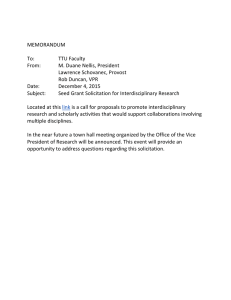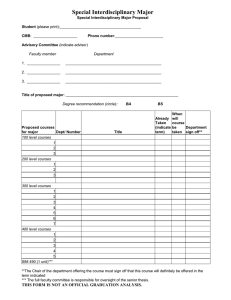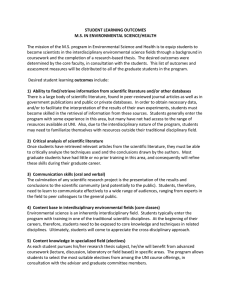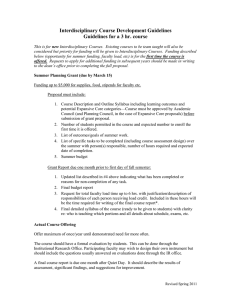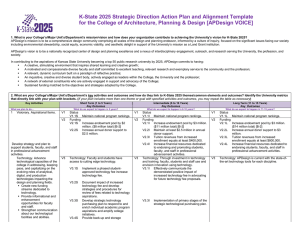Theme 1: Research, Scholarly and Creative Activities, and Discovery (RSCAD) –...
advertisement
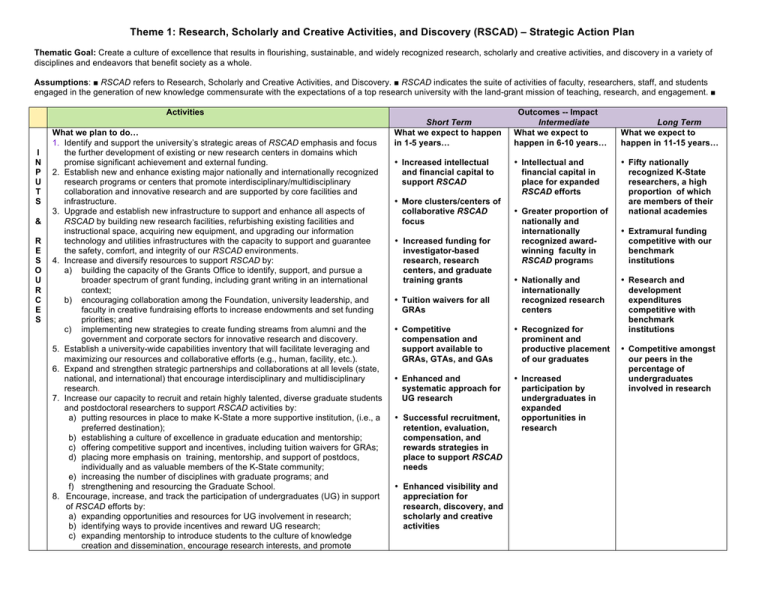
Theme 1: Research, Scholarly and Creative Activities, and Discovery (RSCAD) – Strategic Action Plan Thematic Goal: Create a culture of excellence that results in flourishing, sustainable, and widely recognized research, scholarly and creative activities, and discovery in a variety of disciplines and endeavors that benefit society as a whole. Assumptions: ■ RSCAD refers to Research, Scholarly and Creative Activities, and Discovery. ■ RSCAD indicates the suite of activities of faculty, researchers, staff, and students engaged in the generation of new knowledge commensurate with the expectations of a top research university with the land-grant mission of teaching, research, and engagement. ■ Activities I N P U T S & R E S O U R C E S What we plan to do… 1. Identify and support the university’s strategic areas of RSCAD emphasis and focus the further development of existing or new research centers in domains which promise significant achievement and external funding. 2. Establish new and enhance existing major nationally and internationally recognized research programs or centers that promote interdisciplinary/multidisciplinary collaboration and innovative research and are supported by core facilities and infrastructure. 3. Upgrade and establish new infrastructure to support and enhance all aspects of RSCAD by building new research facilities, refurbishing existing facilities and instructional space, acquiring new equipment, and upgrading our information technology and utilities infrastructures with the capacity to support and guarantee the safety, comfort, and integrity of our RSCAD environments. 4. Increase and diversify resources to support RSCAD by: a) building the capacity of the Grants Office to identify, support, and pursue a broader spectrum of grant funding, including grant writing in an international context; b) encouraging collaboration among the Foundation, university leadership, and faculty in creative fundraising efforts to increase endowments and set funding priorities; and c) implementing new strategies to create funding streams from alumni and the government and corporate sectors for innovative research and discovery. 5. Establish a university-wide capabilities inventory that will facilitate leveraging and maximizing our resources and collaborative efforts (e.g., human, facility, etc.). 6. Expand and strengthen strategic partnerships and collaborations at all levels (state, national, and international) that encourage interdisciplinary and multidisciplinary research. 7. Increase our capacity to recruit and retain highly talented, diverse graduate students and postdoctoral researchers to support RSCAD activities by: a) putting resources in place to make K-State a more supportive institution, (i.e., a preferred destination); b) establishing a culture of excellence in graduate education and mentorship; c) offering competitive support and incentives, including tuition waivers for GRAs; d) placing more emphasis on training, mentorship, and support of postdocs, individually and as valuable members of the K-State community; e) increasing the number of disciplines with graduate programs; and f) strengthening and resourcing the Graduate School. 8. Encourage, increase, and track the participation of undergraduates (UG) in support of RSCAD efforts by: a) expanding opportunities and resources for UG involvement in research; b) identifying ways to provide incentives and reward UG research; c) expanding mentorship to introduce students to the culture of knowledge creation and dissemination, encourage research interests, and promote Short Term What we expect to happen in 1-5 years… • Increased intellectual and financial capital to support RSCAD • More clusters/centers of collaborative RSCAD focus • Increased funding for investigator-based research, research centers, and graduate training grants Outcomes -- Impact Intermediate What we expect to happen in 6-10 years… • Intellectual and financial capital in place for expanded RSCAD efforts • Greater proportion of nationally and internationally recognized awardwinning faculty in RSCAD programs • Tuition waivers for all GRAs • Nationally and internationally recognized research centers • Competitive compensation and support available to GRAs, GTAs, and GAs • Recognized for prominent and productive placement of our graduates • Enhanced and systematic approach for UG research • Increased participation by undergraduates in expanded opportunities in research • Successful recruitment, retention, evaluation, compensation, and rewards strategies in place to support RSCAD needs • Enhanced visibility and appreciation for research, discovery, and scholarly and creative activities Long Term What we expect to happen in 11-15 years… • Fifty nationally recognized K-State researchers, a high proportion of which are members of their national academies • Extramural funding competitive with our benchmark institutions • Research and development expenditures competitive with benchmark institutions • Competitive amongst our peers in the percentage of undergraduates involved in research Activities Short Term graduate school appeal and retention; d) enhancing programs that support UG research, such as the Honors Program and Developing Scholars; and e) establishing a central mechanism to count and track undergraduate students involved in RSCAD efforts. 9. Diversify and increase the number of tenure-line faculty with research expectations. 10.Foster a university culture of productivity, creativity, and innovation that supports and rewards collaboration; interdisciplinary, multi-disciplinary, and multi-institutional work; research, and all types of scholarly activities by: a) increasing the reward and recognition of faculty and staff engaged in RSCAD work; b) encouraging academic units to nominate faculty for national and international awards and recognition; c) developing the faculty to respond to interdisciplinary research opportunities and collaborate in interdisciplinary projects; d) increasing support to assist faculty with their external grant seeking and execution activities, including the preparation and administration of successful large center or interdisciplinary proposals (e.g. administration, release time, core facilities, assistance with collaboration, industry support); e) revising policies at all levels (BOR, university, college, department/unit) to encourage, acknowledge, and reward research and interdisciplinary work and ensure accountability; and f) adapting our internal personnel practices to accommodate the needs of a collaborative research environment and facilitate the hiring and funding of faculty and support personnel participating in interdisciplinary collaboration. 11.Assess RSCAD needs for library resources, including electronic journals. 12.Work aggressively to communicate the need for increased state and national support for the research infrastructure necessary for our country’s future. 13.Establish, promote, and communicate the identity and image of K-State as a topquality public research land grant institution and deploy effective marketing campaigns that brand us as such. 14.Use the Research Infrastructure Task Force report as a template for advancing the goals of RSCAD. 15.Emphasize the importance of the 2025 Vision to faculty, students, alumni and other stakeholders; continue engaging the campus community in the completion of the short-, mid-, and long-term goal fulfillment; and provide regular updates on progress. Outcomes -- Impact Intermediate Long Term
